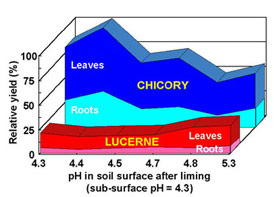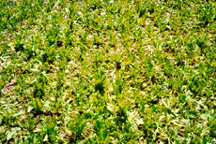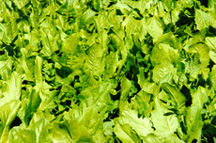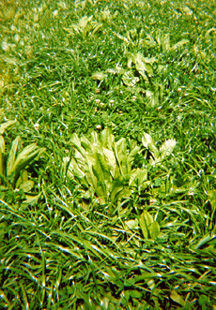
Chicory Part C - Establishment of chicory in pasture
Rainfall and soils

Chicory is best adapted to the higher rainfall areas of NSW (>600 mm in the south, 750+ mm in the north).
Chicory is summer-active and responds well to:
- spring, summer and autumn rainfall;
- irrigation;
- a large amount of water stored in the soil.
It has potential for strong growth from early spring to late autumn, given adequate moisture.
Chicory establishes and grows in a wide range of soil types; however, because of disease risk it is unlikely to persist in heavy clay soils where drainage is poor. Good water-holding soils that are well drained and of medium to high fertility are ideal.
In general it is useful to consider chicory as similar to lucerne, with similar grazing management but more flexible soil requirements. Where lucerne grows well, chicory will have few advantages, with the exception of its ability to set viable seed. Chicory is more tolerant to acid soils than lucerne, making it a particularly attractive option for many tableland grazing properties where low pH and high aluminium saturation prevents the use of lucerne (see Figure C1). Chicory performs well in soils with high aluminium saturation percentages (<30%); however, more extreme levels can inhibit establishment and growth. Tolerance of chicory to salinity is uncertain, although observations to date indicate it can be grown in moderately saline areas. As a deep-rooted summer-growing perennial, chicory is regarded as a useful species for watertable utilisation and control.
General establishment guidelines
- Control broadleaf weeds before sowing, as registered post-emergent herbicide options are limited. Paddock preparation should aim to start a year ahead.
- Chicory can be sown into a cultivated seedbed, or direct drilled, once weeds have been controlled.
- Sow shallow (less than 1 cm) to provide a light covering.
- Use 3 kg seed/ha when sowing as a special-purpose forage. When combined with white clover, sow chicory at the rate of 1–2 kg/ha, and when combined with red clover, sow chicory at the rate of 2–3 kg/ha).
- Use 1–2 kg/ha in perennial pasture mixes. Persistence of chicory may decline in mixed pastures if appropriate grazing management is not practised (stock will preferentially graze chicory).
- Aim for 50–60 plants/m2 for maximum growth in special-purpose pastures.
- Sow with legumes to reduce the need for nitrogen fertiliser.
- Apply phosphate at 20 kg P/ha and nitrogen at 30 kg N/ha at or immediately prior to sowing, unless soil P and N levels are high.
Sowing time
Four main factors should determine sowing time:
- Moisture: Is there enough moisture for germination and development (especially for spring sowing)?
- Temperature: Is there enough time for a seedling to develop before frost and low temperature (autumn), or hot dry weather (spring), occurs? (Chicory establishes rapidly when soil temperatures are over 12°C.)
- Weed control: Will the pasture be struggling against strong weed competition?
- Companion species: Will companion species affect the establishment of chicory?
In NSW tablelands areas, spring sowing is preferred (late August to late September). For the NSW slopes and plains, an early autumn sowing is suitable (March to mid-April), depending on the district and time of the 'break'. Seedlings must be well established prior to onset of frosts. Therefore, spring sowing is preferred where frosts are a risk.
In districts where chicory is strongly winter-dormant, sowing at the beginning of spring is encouraged, as it allows good establishment prior to the warmer months. Alternatively, an early autumn sowing before frosts and extreme cold occur is usually successful, provided the autumn break occurs early enough. Mid-winter sowing is not recommended, as seedlings can be frosted, reducing their ability to compete against weeds. If required, companion perennial pasture species can be sown in the following autumn.
Sowing method

Direct drilled Puna chicory after first grazing
Chicory can be sown using similar equipment and techniques to other small-seeded pasture species. Conventional and minimum tillage techniques are successful, with combine small-seeds boxes, band seeders and direct drilling seeders commonly used. The photo at right shows direct drilled chicory after its first grazing.
Correct sowing depth is critical, with optimal depth being 0.5 cm. Use a roller to compact soil prior to sowing into conventional seedbeds. Rolling after sowing may also improve establishment on non-crusting soils. Spray fallowing and/or the use of pre-emergent herbicides to provide weed control prior to establishment is recommended. Where direct drilling, ensure that slugs are not present, and where necessary lay slug baits at sowing, or after germination if significant slug damage is occurring.
Weed control
Avoid sowing chicory into paddocks where broadleaf weeds are anticipated, until weed populations have been reduced. Applying glyphosate to prevent weed seed-set and to kill previous pasture before sowing is essential for successful establishment. Where conventional cultivation is practised, a pre-emergent herbicide could also be used to control grass weeds. At present, few chemicals are registered for use in chicory for post-emergent broadleaf weed control, although herbicide trials conducted by NSW Department of Primary Industries (NSW DPI) and some private agronomists are showing promising results for a broad spectrum of weeds. Consult an agronomist to determine optimal weed control strategies, which can often be similar to those used for lucerne.
Thistles are very difficult to remove from chicory, so ensure good control of thistles has occurred prior to sowing. Whenever herbicides are applied, graze chicory short to remove leaves prior to application. This will lessen the risk of damage via herbicide uptake.
Weed wiper equipment can be used to selectively apply herbicides to weeds that are standing above chicory after grazing.
Weed control in the year prior to sowing is critical, although once chicory is established it is a vigorous competitor against weeds, and well-established stands will have few weed problems when combined with managed grazing. Strategies for weed control can include:
- pasture topping to prevent weed seed set;
- high sowing rates to encourage competition; and
- top dressing compound fertilisers (N:P:K) in spring, to stimulate chicory growth and aid competitiveness against weeds.
Chicory in a pasture mix
IMAGE NOT FOUND:14908 - may not be published
Chicory can be used in pasture mixes or sown as a special-purpose forage with or without legumes. The persistence and productivity of chicory is greater when managed as a special-purpose forage. Chicory is most productive over spring and summer, and, to maximise production, a high density of chicory plants is required. Subterranean and red and white clovers are suitable companion legumes when sown with a pasture mix, with white and/or red clover proving to be an excellent companion when chicory is sown as a specialist forage crop. The photo at right shows chicory growing with Redquin red clover.

In trials, white clover was found to be the most productive companion legume, having similar growth and grazing responses and being less affected by competition with chicory. The photo at right shows a mixed sward of chicory and white clover. Where soil moisture over summer is limiting, lucerne is not regarded as a suitable companion for chicory, because of direct competition for available soil moisture, and problems with hay production.
In mixed pastures, space is often occupied by other species that are not as productive over summer. It is difficult to manage the need for rest periods for chicory in mixed pastures, where stock will graze chicory preferentially. However, with careful grazing management, chicory has been successfully used in many pasture mixtures. A farmer survey based on the NSW Central Tablelands found that cocksfoot was the grass most commonly sown with chicory, followed by phalaris and tall fescue (Parker & Kemp 1998). Often, the aim with such pastures has been to use chicory in the first few years while the perennial grasses are establishing. Persistence of chicory would be poor in such a pasture system, with the likelihood of the chicory being preferentially grazed and removed quickly from the sward.
Puna chicory sown with ryegrass and sub clover

When sown with perennial ryegrass and sub clover as shown on the right, care must be taken over the winter period to ensure that the crowns of the chicory plants are not damaged while grazing the winter pasture growth.
Cover crops
Ideally chicory is best sown as the principal species, although chicory has been successfully established with cover crops. Cereals and brassica species are the most commonly used cover crops, but it is important that cover crops are not sown at high rates. Shading, competition for nutrients, and competition for moisture will reduce the establishment of chicory.
Where companion crops are used, attention must be paid to grazing management to ensure chicory is not disadvantaged. Chicory foliage is often preferentially grazed by stock. In order to maintain chicory, grazing management should focus on the needs of the chicory.
Cautions
Always read the label
Users of agricultural (or veterinary) chemical products must always read the label and any Permit before using the product, and strictly comply with the directions on the label and the conditions of any Permit. Users are not absolved from compliance with the directions on the label or the conditions of the permit by reason of any statement made or omitted to be made in this publication.
Pasture improvement
Pasture improvement may be associated with an increase in the incidence of certain livestock health disorders. Livestock and production losses from some disorders is possible. Management may need to be modified to minimise risk. Consult your veterinarian or adviser when planning pasture improvement.
The Native Vegetation Conservation Act 1997 restricts some pasture improvement practices where existing pasture contains native species. Inquire through your office of the Department of Infrastructure, Planning and Natural Resources (DIPNR).
Further information
For further information on chicory, see the other parts of Agfact P2.5.40:

